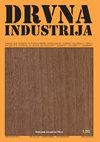木犀草和蓬蓬草浸渍松木和山毛榉木的抗腐性和颜色变化
IF 0.8
4区 农林科学
Q4 MATERIALS SCIENCE, PAPER & WOOD
引用次数: 2
摘要
本研究分析了天然提取物浸渍对松木和山毛榉木材耐腐性和颜色变化的影响。采用水煎法提取黄杜鹃花和ponticum杜鹃花,制备不同浓度(2%、4%和7%)的水溶液。此外,在溶液中加入硫酸亚铁、硫酸铜和硫酸铝媒染剂,以改善提取物的性能。然后用配制好的溶液浸渍木材试件。结果表明,植物种类对暴露于白腐菌的标本质量损失的影响不显著。非媒染剂提取物对样品的质量损失有轻微的影响。然而,在添加了媒介剂(特别是添加了硫酸亚铁)提取物的松树和山毛榉标本中,质量损失显着减少,并且几乎完全实现了对真菌腐烂的抵抗。浓度水平对添加媒染剂提取物处理的标本的质量损失没有显著影响。浸渍后,各试样的L*值(特别是添加硫酸亚铁提取物的试样)均降低,试样变暗。不含媒染剂和添加硫酸铝提取物的试样的a*和b*值增加,试样呈红黄色。添加硫酸铜提取物后,木材试样的a*值降低,b*值升高。这些标本的黄绿色趋势增加。添加硫酸亚铁提取物后,试样的a*值和b*值均降低,绿蓝色倾向增加。浓度水平的增加正影响测定的颜色变化。在添加了硫酸亚铁的ponticum提取物的处理下,木材(尤其是松树)的总颜色变化(ΔE*)更高。本文章由计算机程序翻译,如有差异,请以英文原文为准。
Decay Resistance and Color Change of Pine and Beech Wood Impregnated with R. Luteum and R. Ponticum Plant Extracts
In this study, the effect of impregnation with natural extracts on decay resistance and color change of pine and beech wood was analyzed. Flowers of Rhododendron luteum and Rhododendron ponticum plants were extracted according to the decoction method and aqueous solutions were prepared at different concentration levels (2 %, 4 % and 7 %). In addition, ferrous sulfate, copper sulfate and aluminum sulfate mordants were added to the solution to improve the properties of the extracts. Then the wood specimens were impregnated with the prepared solutions. The results indicated that the effect of plant species on the mass loss of specimens exposed to T. versicolor (white-rot fungus) was insignificant. Non-mordant extracts had a slight effect on the mass loss of the specimens. However, in pine and beech specimens impregnated with mordant-added (especially ferrous sulfate-added) extracts, mass loss was significantly reduced and resistance to fungal rot was almost completely achieved. The concentration level did not have a significant effect on the mass loss of specimens treated with mordant-added extracts. After impregnation, the L* value of all specimens (especially those treated with ferrous sulfate-added extracts) decreased and the specimens darkened. The a* and b* values increased in specimens treated with non-mordant and aluminum sulfate-added extracts and these specimens tend to have a red-yellow color. The a* value decreased and the b* value increased in wood specimens treated with copper sulfate-added extracts. The green-yellow color trend of these specimens increased. Both the a* and b* values of the specimens treated with ferrous sulfate-added extracts decreased and the green-blue color tendency increased in these specimens. The increase in the concentration level positively affected the determined color changes. The total color change (ΔE*) was higher in wood specimens (especially pine) treated with ferrous sulfate-added R. ponticum extracts.
求助全文
通过发布文献求助,成功后即可免费获取论文全文。
去求助
来源期刊

Drvna Industrija
MATERIALS SCIENCE, PAPER & WOOD-
CiteScore
1.80
自引率
9.10%
发文量
32
审稿时长
>12 weeks
期刊介绍:
"Drvna industrija" ("Wood Industry") journal publishes original scientific and review papers, short notes, professional papers, conference papers, reports, professional information, bibliographical and survey articles and general notes relating to the forestry exploitation, biology, chemistry, physics and technology of wood, pulp and paper and wood components, including production, management and marketing aspects in the woodworking industry.
 求助内容:
求助内容: 应助结果提醒方式:
应助结果提醒方式:


